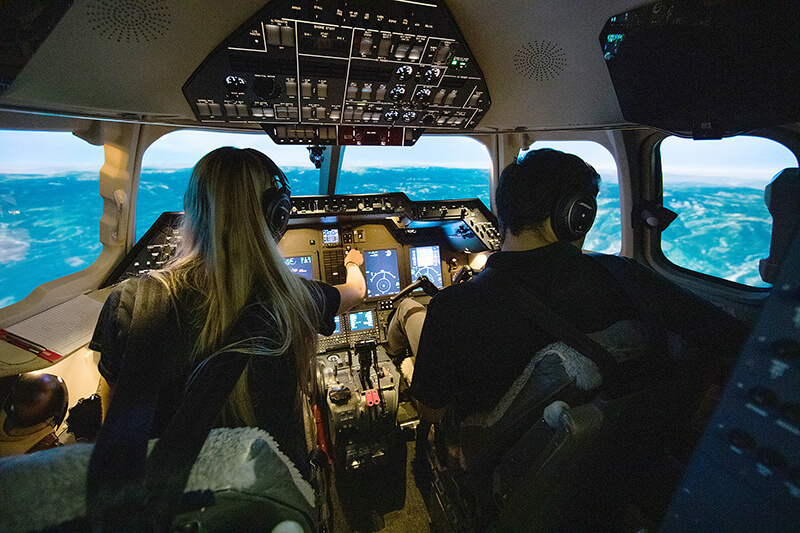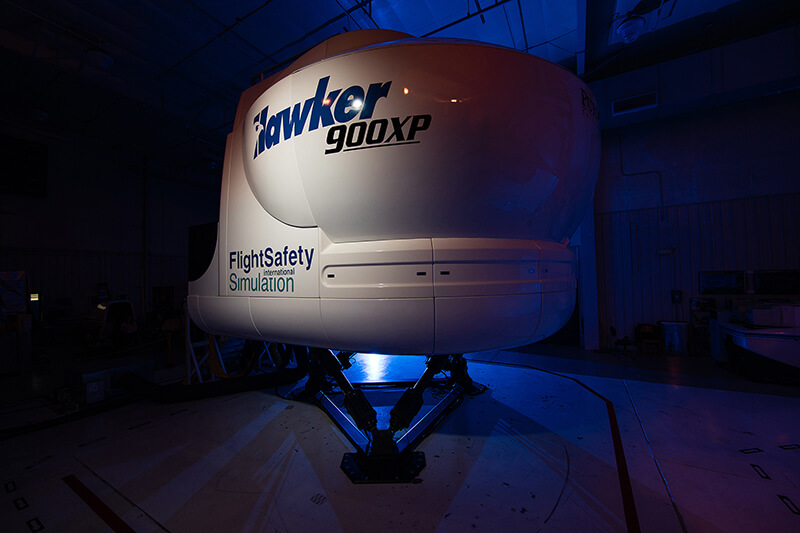November 18, 2019
New Purdue Aviation program, flight simulator address future pilot shortage concerns

Professional flight students from Purdue Polytechnic check their controls as they fly over a fake landscape in the aviation school’s newest flight simulator. (Purdue University photo/Brian Powell)
Hectic annual holiday travel illustrates need for more pilots
WEST LAFAYETTE, Ind. — It’s the beginning of the holiday travel season, and more families are flying. But dropping pilot numbers are making some question how difficult it will be to schedule a convenient flight in the future.
Passenger totals jumped 4% for Thanksgiving alone, clashing with the number of pilots, which has been trending consistently downward for several years, according to FAA figures.
Purdue (University) Polytechnic Institute’s professional flight program has taken two big steps to help match the growing demand for pilots.
The new Degree in 3 program, recently introduced by the School of Aviation and Transportation Technology (SATT), allows select professional flight students to start their degree program en route to completing the traditional four-year program in three years. The move can save participating students $20,000 to $30,000 in tuition and living expenses.
Also aiding the aviation program is new flight simulator technology that provides better training and preparation for professional flight students.
“There is a global shortage of pilots, and we are part of the solution,” said Manoj Patankar, the Raisbeck Engineering Professor of Aviation Technology and head of the school.
In addition to getting students into the job market sooner, partnerships between Purdue and the airline industry also allow students to earn specific technical proficiency for Airbus, Boeing and others before they even graduate.
 Sitting on a two-foot concrete pad, the Hawker 900XP is the largest and latest addition to the array of flight simulators in the School of Aviation and Transportation Technology. (Purdue University photo/Brian Powell)
Download image
Sitting on a two-foot concrete pad, the Hawker 900XP is the largest and latest addition to the array of flight simulators in the School of Aviation and Transportation Technology. (Purdue University photo/Brian Powell)
Download image
“Purdue is certainly leading the pack in terms of being able to graduate students who are job-ready, allowing them to enter the job market sooner,” Patankar said.
Trained professional pilots are a particularly important commodity for the airline industry during the holiday season.
Winter holiday flight totals have jumped substantially in the last six years, increasing from 205,727 flights in 2012 to 443,096 flights in 2018. The U.S. Department of Transportation considers the winter holiday a 21-day period beginning on Dec. 14 and ending Jan. 3.
Purdue’s Hawker 900XP full-flight simulator began operation in September. The in-flight simulator, using the latest technology, is bolstering SATT’s work to put new pilots in the skies. The simulator is qualified at the highest level by the FAA, helping students earn qualifications as a pilot or second-in-command.
The opportunity to utilize summertime flying offers other advantages to professional flight students, according to Brian Dillman, associate professor in aviation and transportation technology.
“The three-year program leverages better flying weather during Indiana’s summers and improves our aircraft utilization – a win-win solution for all,” he said.
Students can find more information about the professional flight Degree in 3 program online at polytechnic.purdue.edu/degrees/professional-flight-degree-3-program.
Writer: Brian Huchel, 765-494-2084, bhuchel@purdue.edu
Sources: Manoj Patankar, 765-496-2837, mspatankar@purdue.edu
Brian Dillman, 765-494-9978, dillman@purdue.edu
Note to Journalists: A produced video for social media is available for download and media use at https://youtu.be/-MnTFusk1Xs. Broadcast-quality b-roll of Purdue student pilots flying in the simulator during an engine fire and an issue with the landing flaps is available here: https://drive.google.com/open?id=1g6HwDkofB65MSF7z4L_fTAIXXXMzsb8k

